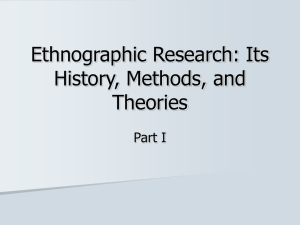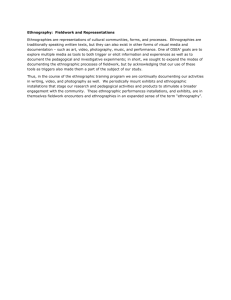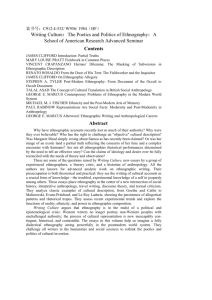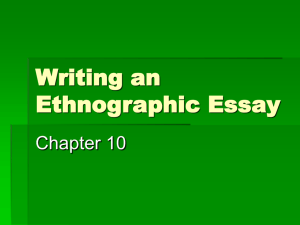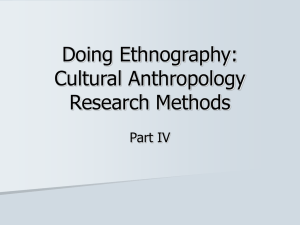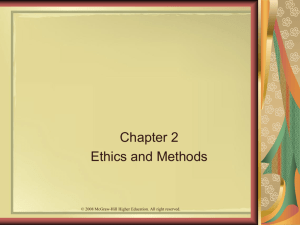Study Note on Ethnography Adapted from http://en.wikipedia.org
advertisement
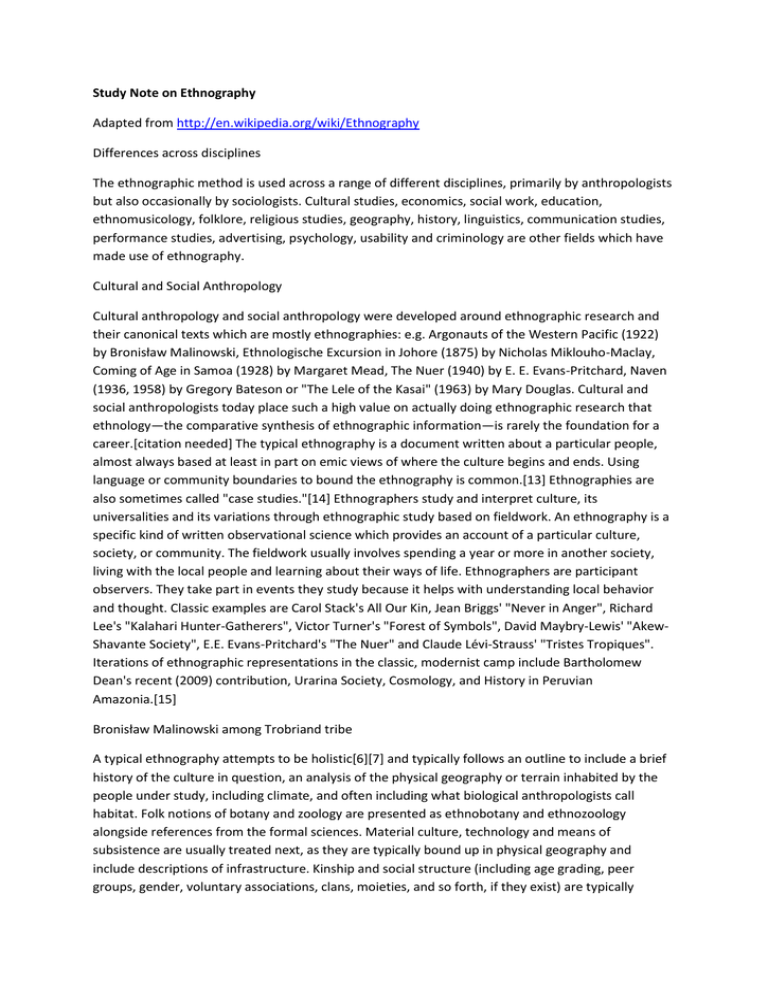
Study Note on Ethnography Adapted from http://en.wikipedia.org/wiki/Ethnography Differences across disciplines The ethnographic method is used across a range of different disciplines, primarily by anthropologists but also occasionally by sociologists. Cultural studies, economics, social work, education, ethnomusicology, folklore, religious studies, geography, history, linguistics, communication studies, performance studies, advertising, psychology, usability and criminology are other fields which have made use of ethnography. Cultural and Social Anthropology Cultural anthropology and social anthropology were developed around ethnographic research and their canonical texts which are mostly ethnographies: e.g. Argonauts of the Western Pacific (1922) by Bronisław Malinowski, Ethnologische Excursion in Johore (1875) by Nicholas Miklouho-Maclay, Coming of Age in Samoa (1928) by Margaret Mead, The Nuer (1940) by E. E. Evans-Pritchard, Naven (1936, 1958) by Gregory Bateson or "The Lele of the Kasai" (1963) by Mary Douglas. Cultural and social anthropologists today place such a high value on actually doing ethnographic research that ethnology—the comparative synthesis of ethnographic information—is rarely the foundation for a career.[citation needed] The typical ethnography is a document written about a particular people, almost always based at least in part on emic views of where the culture begins and ends. Using language or community boundaries to bound the ethnography is common.[13] Ethnographies are also sometimes called "case studies."[14] Ethnographers study and interpret culture, its universalities and its variations through ethnographic study based on fieldwork. An ethnography is a specific kind of written observational science which provides an account of a particular culture, society, or community. The fieldwork usually involves spending a year or more in another society, living with the local people and learning about their ways of life. Ethnographers are participant observers. They take part in events they study because it helps with understanding local behavior and thought. Classic examples are Carol Stack's All Our Kin, Jean Briggs' "Never in Anger", Richard Lee's "Kalahari Hunter-Gatherers", Victor Turner's "Forest of Symbols", David Maybry-Lewis' "AkewShavante Society", E.E. Evans-Pritchard's "The Nuer" and Claude Lévi-Strauss' "Tristes Tropiques". Iterations of ethnographic representations in the classic, modernist camp include Bartholomew Dean's recent (2009) contribution, Urarina Society, Cosmology, and History in Peruvian Amazonia.[15] Bronisław Malinowski among Trobriand tribe A typical ethnography attempts to be holistic[6][7] and typically follows an outline to include a brief history of the culture in question, an analysis of the physical geography or terrain inhabited by the people under study, including climate, and often including what biological anthropologists call habitat. Folk notions of botany and zoology are presented as ethnobotany and ethnozoology alongside references from the formal sciences. Material culture, technology and means of subsistence are usually treated next, as they are typically bound up in physical geography and include descriptions of infrastructure. Kinship and social structure (including age grading, peer groups, gender, voluntary associations, clans, moieties, and so forth, if they exist) are typically included. Languages spoken, dialects and the history of language change are another group of standard topics.[16] Practices of childrearing, acculturation and emic views on personality and values usually follow after sections on social structure.[17] Rites, rituals, and other evidence of religion have long been an interest and are sometimes central to ethnographies, especially when conducted in public where visiting anthropologists can see them.[18] As ethnography developed, anthropologists grew more interested in less tangible aspects of culture, such as values, worldview and what Clifford Geertz termed the "ethos" of the culture. Clifford Geertz's own fieldwork used elements of a phenomenological approach to fieldwork, tracing not just the doings of people, but the cultural elements themselves. For example, if within a group of people, winking was a communicative gesture, he sought to first determine what kinds of things a wink might mean (it might mean several things). Then, he sought to determine in what contexts winks were used, and whether, as one moved about a region, winks remained meaningful in the same way. In this way, cultural boundaries of communication could be explored, as opposed to using linguistic boundaries or notions about residence. Geertz, while still following something of a traditional ethnographic outline, moved outside that outline to talk about "webs" instead of "outlines"[19] of culture. Within cultural anthropology, there are several sub-genres of ethnography. Beginning in the 1950s and early 1960s, anthropologists began writing "bio-confessional" ethnographies that intentionally exposed the nature of ethnographic research. Famous examples include Tristes Tropiques (1955) by Claude Lévi-Strauss, The High Valley by Kenneth Read, and The Savage and the Innocent by David Maybury-Lewis, as well as the mildly fictionalized Return to Laughter by Elenore Smith Bowen (Laura Bohannan). Later "reflexive" ethnographies refined the technique to translate cultural differences by representing their effects on the ethnographer. Famous examples include "Deep Play: Notes on a Balinese Cockfight" by Clifford Geertz, Reflections on Fieldwork in Morocco by Paul Rabinow, The Headman and I by Jean-Paul Dumont, and Tuhami by Vincent Crapanzano. In the 1980s, the rhetoric of ethnography was subjected to intense scrutiny within the discipline, under the general influence of literary theory and post-colonial/post-structuralist thought. "Experimental" ethnographies that reveal the ferment of the discipline include Shamanism, Colonialism, and the Wild Man by Michael Taussig, Debating Muslims by Michael F. J. Fischer and Mehdi Abedi, A Space on the Side of the Road by Kathleen Stewart, and Advocacy after Bhopal by Kim Fortun. This critical turn in sociocultural anthropology during the mid-1980s can, in large part, be traced to the influence of the now classic (and often contested) text, Writing Culture: The Poetics and Politics of Ethnography, (1986) edited by James Clifford and George Marcus. Writing Culture helped bring changes to both anthropology and ethnography often described in terms of being 'postmodern,' 'reflexive,' 'literary,' 'deconstructive,' or 'poststructural' in nature in that the text helped to highlight the various epistemic and political predicaments that many practitioners saw as plaguing ethnographic representations and practices.[20] Where Geertz's and Turner's interpretive anthropology recognized subjects as creative actors who constructed their sociocultural worlds out of symbols, postmodernists attempted to draw attention to the privileged status of the ethnographers themselves. That is, the ethnographer cannot escape their own particular viewpoint in creating an ethnographic account thus making any claims of objective neutrality on the part of their representation highly problematic, if not altogether impossible.[21] In regards to this last point, Writing Culture became a focal point for looking at how ethnographers could describe different cultures and societies without denying the subjectivity of those individuals and groups being studied while simultaneously doing so without laying claim to absolute knowledge and objective authority.[22] Along with the development of experimental forms such as 'dialogic anthropology' and 'narrative ethnography,' Writing Culture helped to encourage the development of 'collaborative ethnography.'[23] This exploration of the relationship between writer, audience, and subject has become a central tenet of contemporary anthropological and ethnographic practice wherein active collaboration between the researcher(s) and subject(s) has helped blend, in certain instances, the practice of collaboration in ethnographic fieldwork with the process of creating the actual ethnographic product that emerges from the research itself.[23][24][25]
